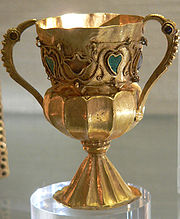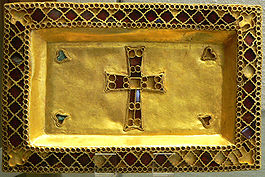
Treasure of Gourdon
Encyclopedia

Gourdon
Gourdon is the name or part of the name of several communes in France:* Gourdon, in the Alpes-Maritimes département* Gourdon, in the Ardèche département* Gourdon, in the Lot département* Gourdon, in the Saône-et-Loire département...
, Saône-et-Loire
Saône-et-Loire
Saône-et-Loire is a French department, named after the Saône and the Loire rivers between which it lies.-History:When it was formed during the French Revolution, as of March 4, 1790 in fulfillment of the law of December 22, 1789, the new department combined parts of the provinces of southern...
, in 1845, is a hoard of gold, the objects dating to the end of the fifth or beginning of the sixth century, which was secreted soon after 524. When it was found the hoard comprised a chalice
Chalice (cup)
A chalice is a goblet or footed cup intended to hold a drink. In general religious terms, it is intended for drinking during a ceremony.-Christian:...
and a rectangular paten
Paten
A paten, or diskos, is a small plate, usually made of silver or gold, used to hold Eucharistic bread which is to be consecrated. It is generally used during the service itself, while the reserved hosts are stored in the Tabernacle in a ciborium....
, that were similarly applied with garnets and turquoises in cloisonné
Cloisonné
Cloisonné is an ancient technique for decorating metalwork objects, in recent centuries using vitreous enamel, and in older periods also inlays of cut gemstones, glass, and other materials. The resulting objects can also be called cloisonné...
compartments, together with about a hundred gold coins dating from the reigns of Byzantine emperors Leo I
Leo I (emperor)
Leo I was Byzantine Emperor from 457 to 474. A native of Dacia Aureliana near historic Thrace, he was known as Leo the Thracian ....
(457–474) through that of Justin I
Justin I
Justin I was Byzantine Emperor from 518 to 527. He rose through the ranks of the army and ultimately became its Emperor, in spite of the fact he was illiterate and almost 70 years old at the time of accession...
(518–527). The Merovingian king Clovis I
Clovis I
Clovis Leuthwig was the first King of the Franks to unite all the Frankish tribes under one ruler, changing the leadership from a group of royal chieftains, to rule by kings, ensuring that the kingship was held by his heirs. He was also the first Catholic King to rule over Gaul . He was the son...
converted to Christianity in 496; the chalice and paten might be called early Merovingian or late Gallo-Roman.
The treasure is preserved in the Cabinet des Médailles
Cabinet des Médailles
The Cabinet des Médailles, more formally known as Département des Monnaies, Médailles et Antiques de la Bibliothèque nationale de France, is a department of the Bibliothèque nationale de France in Paris, France, housed in its former premises in Rue de Richelieu.The Cabinet des Médailles is a museum...
, Paris, a department of the Bibliothèque nationale.
In the sixth century Gourdon was the site of a monastery, whence these objects may have come. The latest date among the coins that were part of the hoard can be fixed at circa 524. The treasure may have been hastily buried in anticipation of a raid. Its recovery was fortuitous: a shepherd girl, Louise Forest, discovered it below a Roman tile engraved with a cross. The treasure was sold at auction in Paris, 20 July 1846, when the paten and chalice were acquired by the State, whereas the documentary coins were dispersed and lost to view.

The chalice may be compared to the canthares of ceramic or metal in common use among the Romans for wine cups. By contrast, the decor is "barbarian
Barbarian
Barbarian and savage are terms used to refer to a person who is perceived to be uncivilized. The word is often used either in a general reference to a member of a nation or ethnos, typically a tribal society as seen by an urban civilization either viewed as inferior, or admired as a noble savage...
", in both iconography and technique, typically light and portable, and employing the cloisonné technique. Comparable bird motifs may be traced in Visigoth
Visigoth
The Visigoths were one of two main branches of the Goths, the Ostrogoths being the other. These tribes were among the Germans who spread through the late Roman Empire during the Migration Period...
, Lombard
Lombards
The Lombards , also referred to as Longobards, were a Germanic tribe of Scandinavian origin, who from 568 to 774 ruled a Kingdom in Italy...
and Merovingian metalwork.
The rectangular paten is 19.5cm by 12.5cm, and 1.6 cm deep. It presents a border of cloisonné garnets, a central cross in garnets and four corner motifs of turquoise. The cross unequivocably identifies the ensemble as Christian.
The 520s in eastern Gaul
Gaul
Gaul was a region of Western Europe during the Iron Age and Roman era, encompassing present day France, Luxembourg and Belgium, most of Switzerland, the western part of Northern Italy, as well as the parts of the Netherlands and Germany on the left bank of the Rhine. The Gauls were the speakers of...
witnessed the war against the Burgundians
Burgundians
The Burgundians were an East Germanic tribe which may have emigrated from mainland Scandinavia to the island of Bornholm, whose old form in Old Norse still was Burgundarholmr , and from there to mainland Europe...
that was waged by the four successors of Clovis. It came to a decisive end with the Battle of Vézeronce
Battle of Vézeronce
The Battle of Vézeronce took place on June 25, 524 close to Vézeronce-Curtin in Isère. It was part of the Burgundian War initiated by the four successors of the Frankish king Clovis I: Childebert I, Chlodomir, Chlothar I, and Theuderic I....
, in 524, with a conclusive Burgundian defeat.

